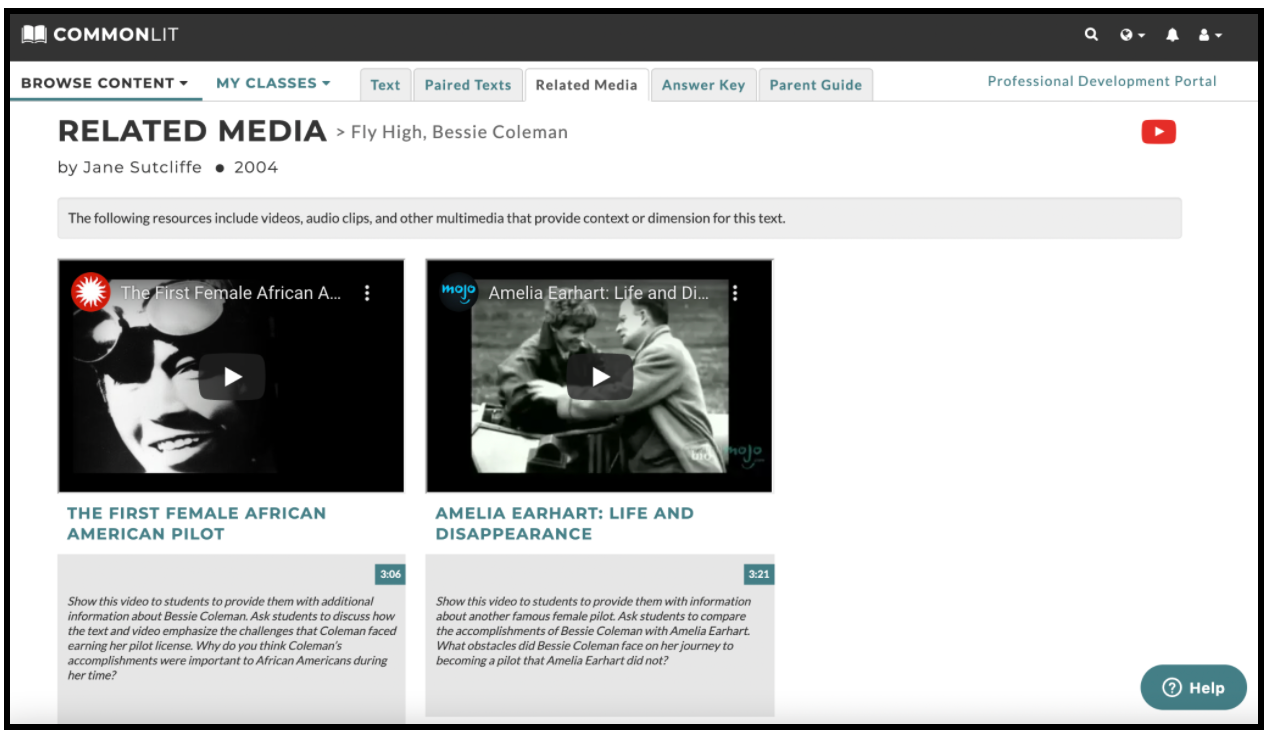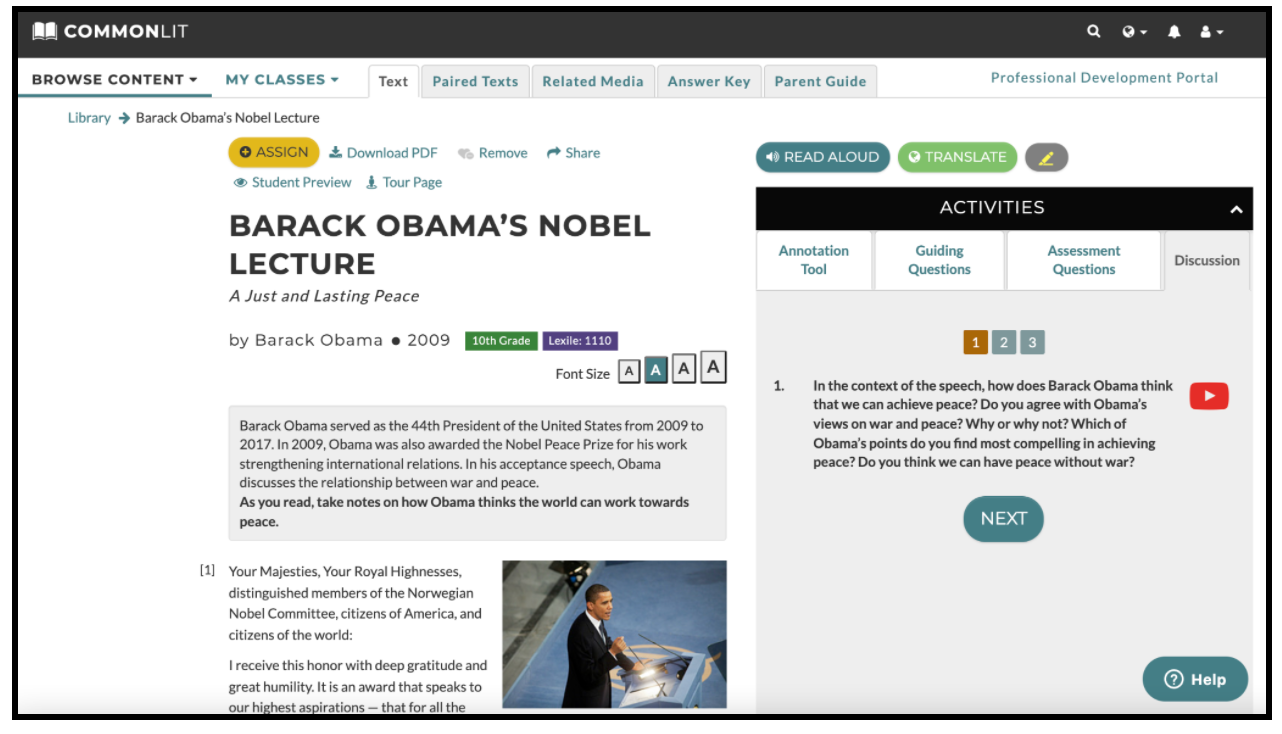Use these texts to teach your students about the incredible ways people have changed the world.
Reading about amazing people who have changed the world helps students envision the changes they want to make in their communities. These texts about acts of compassion, creativity, selflessness, and defiance that have happened throughout history will energize your students to make a difference.
Check out these 10 moving texts from CommonLit about world-changing individuals whose passion will inspire your students!
“Sí Se Puede! The Legacy of Cesar E. Chavez” by Carlos Lossada (3rd Grade)
In this biography, the author describes the life of Cesar Chavez, an American civil rights leader who was known for protecting the rights of farm workers. He used peaceful protest and treated all people with respect, encouraging everyone to try to imagine others’ perspectives. After reading, help students make text-to-self connections with Discussion Question 3, “In the text, the author describes how Cesar Chavez fought for what he believed in. What is something that you believe in? What can you do to support this cause?”
“Fly High, Bessie Coleman” by Jane Sutcliffe (4th Grade)
In this informational text, students will learn about Bessie Coleman, the first African American woman to receive her pilot license. By defying societal expectations for African American women, Coleman inspired many to pursue their dreams of becoming pilots. After reading, show students the video “The First Female African American Pilot” under the “Related Media” tab and ask why they think Coleman’s accomplishments were important to African Americans during her time.

“The Life and Achievements of Thomas Edison” by Jessica McBirney (5th Grade)
In this biography, Jessica McBirney describes the contributions of Thomas Edison, an American inventor and businessman whose inventions included the phonograph, the motion picture camera, and the light bulb. Edison’s creativity and drive have inspired inventors all over the world. Pair this text with the lesson entitled “Today’s Telephone,” and have your students compare and contrast how Alexander Graham Bell’s invention of the telephone and Edison’s inventions affected life in America.
“Daisy Low Grows the Girl Scouts” by Natasha Wing (6th Grade)
Juliette “Daisy” Gordon Low was the founder of the Girl Scouts in the United States. In this informational text, Natasha Wing explores why the Girl Scouts was important to Low and how she established the organization. After reading, have students analyze Low’s contributions by asking Discussion Question 2, “In what ways was Daisy a leader in establishing the Girl Scouts? What characteristics made Daisy a good leader?”
“Elie Wiesel’s Nobel Acceptance Speech” by Elie Wiesel (8th Grade)
Elie Wiesel (1928–2016) was a Romanian-born Jewish American writer, professor, political activist, and Holocaust survivor. During World War II, Wiesel and his family were transported to a German concentration and extermination camp, where his parents and one of his sisters died. In this speech, Wiesel accepts the 1986 Nobel Peace Prize for his work promoting human rights. As students read, have them follow the annotation task, which asks them to take notes on the imagery Wiesel uses. After reading, they can discuss the power of Wiesel’s words.

“Malala Yousafzai’s Nobel Peace Prize Lecture” by Malala Yousafzai (8th Grade)
In this speech, Pakistani education activist and youngest-ever Nobel Prize laureate Malala Yousafzai discusses her commitment to education. Because of her activism, she was shot and nearly killed by the Taliban — but this experience has not stopped her from fighting for equal rights for all. You could assign this text alongside “Emma Watson’s United Nations: ‘HeForShe: Gender Equality is Your Issue, Too’ Speech” and have your students discuss Yousafzai’s and Watson’s perspectives on how inequality impacts girls’ futures.
“Nelson Mandela’s Nobel Peace Prize Lecture” by Nelson Mandela (9th Grade)
Nelson Mandela was a South African leader who worked to end apartheid, a system of racial segregation and discrimination in South Africa. Mandela later served as South Africa’s first black president. In 1993, Mandela and F.W. de Klerk, the last head of state of South Africa under the apartheid era, received the Nobel Peace Prize jointly for their work ending apartheid. To build background knowledge before reading this speech, have your students watch “How Does the Nobel Peace Prize Work?” under the “Related Media” tab.
“Barack Obama’s Nobel Lecture” by Barack Obama (10th Grade)
Barack Obama served as the 44th President of the United States from 2009 to 2017. In 2009, Obama was also awarded the Nobel Peace Prize for his work strengthening international relations. In his acceptance speech, Obama discusses the relationship between war and peace. After reading, spark a debate with Discussion Question 1, “Do you agree with Barack Obama’s view on war and peace? Why or why not? Do you think we can have peace without war?”

“Jimmy Carter’s Nobel Lecture” by Jimmy Carter (11th Grade)
Jimmy Carter served as the 39th President of the United States from 1977 to 1981. Following his presidency, Carter set up the Carter Center with the goal of advancing human rights and combating human suffering. In 2002, Carter received the Nobel Peace Prize for his work promoting international peace. After reading, extend students’ learning by showing them the video “The Carter Center” under the “Related Media” tab to provide more information about Carter’s efforts.
“Martin Luther King, Jr. Nobel Acceptance Speech” by Martin Luther King, Jr. (11th Grade)
Martin Luther King, Jr. was an American Baptist minister and activist known for his use of nonviolent civil disobedience to protest against racial injustice. In 1964, King was awarded the Nobel Peace Prize for his contributions to the Civil Rights Movement. After reading, have students make text-to-world connections with Discussion Question 1, “In the context of the text, how do people create change? What ideas did King contribute to the Civil Rights Movement that changed the fight for freedom? How do his ideas compare to leaders of other political and social movements?”
Next Steps
Looking for more great texts to share with your students? Check out our CommonLit library!
If you’re interested in learning all about CommonLit’s free digital literacy program, join one of our upcoming webinars!


